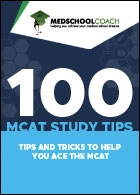
Table of Contents
A medical school letter of intent is when you want to inform (typically via email) one particular med school that they are your top choice. Medical schools want to offer acceptance to applicants who will actually attend, so a letter of intent may increase your odds of acceptance.
Although not legally binding, a letter of intent (LoI) is ethically serious. Only send an LoI to your top choice school where you would 100% attend if offered a spot. Do not send an LoI if you would accept any other schools’ offers.
This letter should communicate why you want to attend that school and why you would be a good fit, all about one page in length. It should be formal, specific, and direct — not generic.
Below are some step-by-step instructions on writing a letter of intent for medical school.
Get comprehensive support to create a medical school application that stands out.
What to Include
You only have about one page to explain why a certain school is the right fit for you and vice-versa, and you can’t sound generic. So we’ve split up this guide on how to write a formal letter of intent into five sections of an LoI:
- The right contacts
- Personal introduction and purpose for writing
- Why the school is your top choice
- Recent and relevant accomplishments
- A clean conclusion
Below this step-by-step guide, we’ve included what to avoid in an LoI, formatting tips, when to send, and even a letter of intent example! Skip ahead if that’s what you’re looking for.
The Right Contacts
You need to communicate with the people making the decisions, so don’t waste your time sending a letter of intent to a generic “info@” email address.
Do your research and find out who the dean or director of admissions is. If you really clicked with a particular interviewer, you should include him or her on the cc line as well.
Use the correct titles and spellings when addressing your letter. Don’t say “Dear Dean of Admissions,” — say “Dear Dr. John Smith” to inject a personal touch.
Related: How To Get Off the Waitlist
Schools may have separate email addresses or a communications or application portal meant for letters of intent, so confirm you’re sending the LoI to the correct place.
Personal Introduction and Purpose for Writing
Introduce yourself quickly and get straight to why you are writing to the school. Don’t oversell yourself at this point. You’ll get to mention recent accomplishments in later sections. See the example below.
My name is John Doe, and I am a current applicant to Best University School of Medicine who interviewed on December 1st. I am writing this letter firstly to reiterate that Best University School of Medicine is my top choice for medical school, secondly to explain why I am a good fit for the school, and thirdly update you on new accomplishments that may not be in my current file.
Learn More: Letter of Intent for Residency Match
Pro tip — include your AAMC ID at the top or bottom of the letter.
Why the School Is Your Top Choice (And Vice-Versa)
Give legitimate and personalized reasons why you would attend this medical school over any other program.
Include any memorable moments from your interview. If you enjoyed your time with your interviewer, mention that as well.
There might be aspects of the school’s culture, location, or mission that would really mesh with your personality, learning style, or goals. You can talk about how the school’s vision, mission statement, or specific uniquenesses resonate with you.
Find out your odds of getting into your preferred medical program.
Check out this example of talking about why this school is your ideal choice.
This school is my top choice because of its (specific program name). Your vision and mission align with mine more than other medical colleges, and I appreciated (specific elements of school culture) when I interviewed there.
Seamlessly transition from the school’s best qualities to your best qualities. Humbly answer these two questions:
- What makes you stand out as a med school candidate?
- What value would you personally offer the school as a medical student and future alum?
Recent and Relevant Accomplishments
Here’s where you can highlight your recent and relevant accomplishments; be confident, but don’t be arrogant. Include newsworthy updates that aren’t in your primary application, secondary application, or (optional) update letters.
You can talk about your upcoming plans and near-future accomplishments. You can include things like:
- A new research publication
- Leadership endeavors
- New clinical experiences or physician shadowing
- Recent achievements at your job or volunteer place
Turning your letter of intent into a hybrid LoI-update letter like this increases the quality and strength of the LoI.
Read Next: A Year Off Before Medical School
A Clean Conclusion
Give a final statement that reiterates your interest. Concisely thank them and express how you look forward to the rest of the admissions process.
Use a professional closing such as “Sincerely,” or “Best wishes.”
I hope I can contribute my skills and experiences to my ideal MD program. Thank you for your time, and I look forward to the rest of this admissions process.
Sincerely,
Jane Doe
Read More: Sample Interest Letter for Pre-Med Research
What to Avoid
Here’s a quick list of what to avoid when you’re writing a good letter of intent for medical school:
- Don’t lie. Don’t pretend like a school is your top choice if it’s not. Don’t tout achievements that aren’t true.
- Don’t be vague. Give a clear statement that you will attend the school if offered a spot. Don’t say “very likely” or “highly interested;” that could be construed as not being sure.
- Don’t send it before your interview. Sending an LoI before an interview is typically seen as premature, making admissions committees think you are hasty or disingenuous. Wait until after you interview at multiple schools. Being put on a medical school waitlist post-interview is a good justification for sending an LoI.
- Don’t include fluff. You only have about one page to accomplish a lot of things in your letter of intent. Don’t include fluff — irrelevant sentences just taking up space. Don’t waste space repeating info you’ve given them before, including anything on your application(s).
- Don’t copy and paste. A generic letter or one written by AI is recognizable and will be seen as a mark against you. Feel free to use templates and get inspiration from examples, but write an original, personalized letter.
- Don’t beg. You don’t want to look desperate. Maintain a professional tone. Express why the school is a good fit for you and vice-versa, but no begging.
- Don’t sound entitled. Never say, “I deserve a spot.” Instead, be grateful.
- Don’t be sloppy. Please, please, please don’t misspell a dean’s name, address the wrong school, leave in grammatical and spelling errors, or make other sloppy mistakes.
Formatting and Other Considerations Before You Hit “Send”
Below are our recommendations for letter of intent formatting and other considerations before you send that LoI email:
- Use a readable font. Acceptable fonts are Times New Roman, Arial, or Calibri. Font size should be 11 or 12. Don’t use funky colors, excessive bold or italics, highlighting, or emojis.
- Keep it concise. Stick to 3-5 paragraphs, about 300-500 words. If your LoI is more than one page in Microsoft Word/Google Docs, you need to cut something.
- Proofread. We recommend running your letter through ChatGPT, Grammarly, or even the Hemingway Editor to check for grammar, spelling, and ease of reading. We also suggest letting a peer or mentor read over your LoI before sending it.
- Download as a PDF with a clear title. PDFs preserve formatting across all devices, making them the best file format for email attachments. When you download the PDF, title it clearly: “LastName_FirstName_LetterofInterest.pdf”
- Send a professional email. Include a professional subject, such as “Letter of Intent [Full Name]”. Write a professional greeting, one line to briefly explain that the attached PDF is a med school letter of intent, and a “Thank you” or “Sincerely” to end it. Don’t forget to attach the PDF LoI.
Read Next: Med School Letters of Recommendation — Who and How To Ask
When to Send
Do not send a letter of intent until after you have interviewed. Start drafting an LoI as soon as you have interviewed at your top-choice school. (Reminder: You should only send letters of intent to one school. Letters of interest, however, can be sent to multiple schools.)
Sending a letter of intent before or at the start of the interview season may look hasty, disingenuous, desperate, and premature. You want to look level-headed, thoughtful, and professional.
If you’re put on the post-interview waitlist at your top choice school, that is a good time to send an LoI. A well-crafted letter of intent can make you stand out among other waitlisted candidates.
You can be aggressive when it comes to contacting a school and writing letters of intent. If you are really interested in one school, it may be helpful to your candidacy to write multiple letters of intent to that school — as long as each letter includes updates to your accomplishments.
A good guideline would be to send a letter once a month, beginning the month after you are interviewed. Just make sure that each letter is unique, informative, and professional.
Letter of Intent Sample
Below is a sample letter of intent for medical school. Reminder — do not copy and paste, but definitely use this as a template or inspiration for your personalized LoI.
Dear [Dean or Director of Admissions, depending on the school],
My name is John Doe, and I am currently applying to Best University School of Medicine (BUSOM). I interviewed on December 1st and am writing this letter for three purposes. My first purpose is to reiterate that BUSOM is my clear top choice for medical school. If accepted, I will definitely attend BUSOM. Second, I hope to express why I am a good fit for your school. Last, I wanted to update you on any new accomplishments that may not be in my current applicant file.
During my interview with Dr. Awesome, I asked her how I should decide which school to go to. Her main advice was to figure out which school was the best fit for me. After attending multiple interviews and learning extensively about different schools, I believe that BUSOM is truly the best fit for me. I agree wholeheartedly with the vision and mission of the school, especially the focus on serving both the local and global community. BUSOM’s emphasis on PBL and small groups is extremely enticing to me because I, too, value hands-on and group learning. On my interview day, I definitely felt at home. I loved the passion and warmth of the faculty. The speech by Dr. Perfect was amazing in welcoming and inspiring all of us interviewees. In addition, I could not help but notice how genuinely happy BUSOM’s medical students were. They repeatedly expressed how much they loved the school. All the students walking by had smiles on their faces and greeted us kindly.
BUSOM is renowned for producing intelligent, mature, and diligent physicians. I believe I have what it takes to live up to BUSOM’s standard of excellence. Since graduating from Awesome University, I have been working full-time as a clinical research associate. As a clinical researcher, I have consistent exposure to patients as I enroll them into our study. Right now, I am learning how to effectively communicate with patients, but I know that BUSOM will further prepare me to become the best clinician I can possibly be.
Our research team recently submitted a paper for our project on breast cancer that will be appearing in Nature. As author of the paper, I contributed by collecting and analyzing data, helping design the study, writing and editing the manuscript, and critically evaluating methods of dissemination. BUSOM is a place where cutting-edge research never stops. My intent is to continue its tradition of research greatness.
I would be honored to attend BUSOM. I know that I can make a positive contribution to the school. Thank you so much for your consideration. I hope to see you in the fall!
Best wishes,
John Doe
AAMC ID: 12382390
FAQs
The differences between a letter of intent and a letter of interest are that the intent letter is binding while the interest letter is less effective:
- A letter of intent is a great way to tell a medical school that you will accept admission if they offer it — and you have to commit to that decision, lest you sacrifice your reputation. (Academics talk to one another.) This optional action may increase your odds of acceptance if a med school knows they’re your first choice. You should send a letter of intent to just one school, where you would definitely go if offered a spot.
- A letter of interest is an optional indication that a certain medical school is one of your top choice schools. While the letter of interest does not commit you to accepting an admissions offer from a particular medical school, it also has less of an advantageous effect. You may send letters of interest to multiple medical schools.
Update letters tell schools you’re applying to about new accomplishments or significant grades. Update letters inherently indicate your continued interest in a program. It is non-binding, and you can send update letters to multiple schools.
A letter of intent should only ever be sent to one program. It is an ethically-binding contract that you will accept admission if the school offers it. You may add an update to a letter of intent, strengthening the effectiveness of the LoI. You may send an update letter after an LoI.
Sending a letter of intent after you’re on the post-interview waitlist can be very strategic. As accepted applicants may choose other schools, Admissions offices are looking for anything to set waitlisted applicants apart. An LoI may push you to the front of the waitlisted field.
We recommend sending a letter of intent only after being interviewed, so don’t send one if you’re on the pre-interview waitlist. Also, don’t send a letter of intent to more than one school. And don’t send an LoI unless you are 100% ready to attend if offered a spot.
Improve Your Chances of Acceptance With MedSchoolCoach
A letter of intent is one way to increase your odds of acceptance at your dream school. Other methods include efficient MCAT studying, AMCAS or AACOMAS consulting, interview prep, and a killer personal statement.
We can help you with all your med school application needs. The students we work with have a higher rate of acceptance and are more likely to get into their top-choice school.
Our 99th-percentile MCAT tutors, physician advisors, and professional writers can boost your odds of medical school acceptance.

Sahil Mehta MD
Dr. Mehta is the founder of MedSchoolCoach and has guided thousands of successful medical school applicants. He is also a practicing physician in Boston where he specializes in vascular and interventional radiology.





